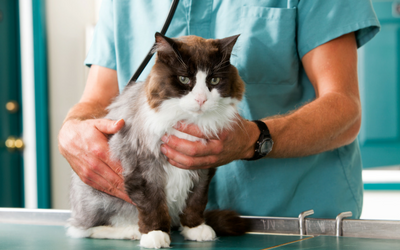Systemic Hypertension (High Blood Pressure) in Cats
What is blood pressure?
Blood pressure refers to the pressure against the walls of arteries during the time the heart contracts and empties itself of blood as well as during the time the heart relaxes and fills with blood.
When the heart contracts, this is known as systole, and the systolic pressure is the maximum pressure against the walls of the arteries. When the heart relaxes, it is known as diastole, and diastolic pressure is the minimum pressure against the walls of the arteries.
How is blood pressure measured in cats?
Measuring blood pressure in your cat is very similar to having your own blood pressure measured. In general, your cat will be taken to a quiet room and gently laid on her side, giving her time to calm down. If your veterinarian is using a Doppler method of measurement, they will usually shave a small patch of fur on the underside of your cat’s metacarpal (wrist) or metatarsal (ankle) and a small probe will be taped in place. An appropriate-sized cuff will then be placed above this area and inflated, just like your own doctor would do. As the cuff is deflated, your veterinarian will listen for the pulsing sound of the blood to be heard, at which point the systolic blood pressure will be recorded (unfortunately, determining diastolic blood pressure in pets with this technique is very difficult and unreliable).
Generally, several measurements will be taken over a period of a few minutes, with the results being averaged out.
What is systemic hypertension?
Systemic hypertension describes high blood pressure throughout the entire body. This means a sustained elevation in systolic pressure of 140mmHg or greater, in diastolic pressure of 90mmHg or greater, or both.
Cats can experience temporary elevations in blood pressure due to stress effects, including just being in a veterinary hospital. It is important to take several readings and to create as quiet an environment as possible. Hypertension in cats is often due to an underlying disease and is called secondary hypertension. If no underlying disease is present or can be identified, then it is called primary hypertension.
"Systemic hypertension describes high blood pressure
throughout the entire body."
Hypertension is more common in older cats, consistent with the development of underlying disease such as chronic kidney disease, or excessive levels of thyroid hormone from a functional (but benign) thyroid tumor. Younger cats may develop hypertension if they have kidney disease due to infection (such as leptospirosis) or a developmental kidney abnormality.
What are the signs of hypertension?
Signs of hypertension include:
- sudden blindness, bleeding inside the globe of the eye, and persistently dilated pupils
- detached retinas
- nervous system signs like depression, head tilt, seizures, disorientation, wobbly or uncoordinated movements (called ataxia), circling, weakness or partial paralysis, or short, rapid, back-and-forth movements of the eyes (called nystagmus)
- increased drinking and urinating with the progression of chronic kidney disease
- blood in the urine (called hematuria)
- bleeding in the nose and nasal passages (known as epistaxis or a nosebleed)
- heart murmurs or abnormal heart rhythms
What causes hypertension?
The cause of primary hypertension is unknown. Secondary hypertension accounts for a majority of hypertension in cats, and can be attributed to kidney disease, thyroid disease, diabetes mellitus (less common), pheochromocytoma (adrenal gland tumor and very uncommon), or central nervous system disease (very rare).
How is hypertension treated?
The treatment of cats with hypertension depends upon the underlying cause, if any. If the cat develops a serious complication related to hypertension like acute kidney failure or bleeding into the eye, there may be a need for hospitalization. In general, once any underlying condition is appropriately managed, medication and nutrition are important to normalizing blood pressure.
"Therapeutic nutrition is generally accepted
as an important part of long-term management.”
Medications that are commonly used to manage hypertension in cats include angiotensin converting enzyme (ACE) inhibitors, angiotensin II receptor antagonists (ARBs), beta blockers, and calcium channel blockers. Additional medications may be required depending upon the response to initial therapy. Therapeutic nutrition is generally accepted as an important part of long-term management.
What kind of monitoring will be required?
The treatment goal for a cat with hypertension is a systolic pressure of 140mmHg or less, and a diastolic pressure of 90mmHg or less. Periodic laboratory testing will be required to monitor for side effects of medication and progression of disease.
Potential complications of hypertension in the cat include:
- congestive heart failure
- chronic kidney disease
- retinal degeneration and subsequent blindness
- bleeding into the eye
- stroke (cerebral vascular accident)
What is the prognosis for hypertension?
The course of feline hypertension is dictated by the underlying cause. When blood pressure is well managed, the risks for potential complications are minimized. Medication for hypertension is generally a lifetime undertaking and may be adjusted over time as needed.






